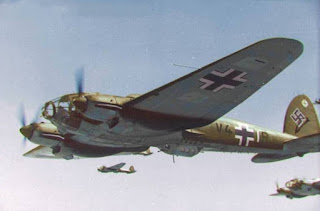In October 1939 the SS-Standarte Der Führer, Deutschland and Germania were organized into the SS-Verfügungs-Division. Both the SS-V-Division and the full independent motorized infantry regiment Leibstandarte SS would take part in the upcoming Western campaign. On Friday May 10 1940, Nazi Germany launched its offensive into the Netherlands and Belgium. The breaking of Rights of Neutrality were not considered by Germany, in the view of the far from neutral behavior, not only of Belgium, of Holland as well. The German offensive took its course from the North Sea to the southern border of Luxembourg. The Leibstandarte SS formed the vanguard of the ground advance into the Netherlands and the SS-V-Division saw action in the main drive for the Dutch central front and Rotterdam. Germany's Blitzkrieg conducted with great speed and force by massed mechanized ground forces and air forces in close cooperation rapidly overpowered the defences of the Netherlands and Belgium. After the surrender of the Netherlands on May 15 1940, the Waffen-SS was transferred to France. At the end of the campaign, the SS-V-Division had advanced all the way to the Spanish frontier. Top image: a squadron of German Heinkel He 111 bombers in flight in 1940. Photo by Kriegsberichter Dahm. Credit: Richard James Molloy. c. Bundesarchiv. Second image: German Fallschirmjägers of the Luftlande-Sturm-Regiment 1 known as Sturmabteilung Koch shown here after the extraordinary success in the capture of the Belgian Fort Eben-Emael on the Belgian-Dutch border between May 10 and May 11 1940. Photo taken at the Luftwaffe barracks in Köln-Dellbrück by KB Oberleutnant Büttner. Credit: Julius Backman. c. Bundesarchiv. Third image: German soldiers examine damage
after the Rotterdam Blitz on May 14 1940. The air attack on Rotterdam, mistakenly carried out by the German Luftwaffe because tragically, for reasons of communication, it could not be halted. Wehrmacht General Rudolf Schmidt used the threat of bombing Rotterdam to attempt to force the Dutch Colonel P. W. Scharroo to surrender the city. Rotterdam was the largest industrial centre in the Netherlands and of major strategic importance to the Germans. Scharroo refused and stretched out negotiations. The start of the air raid had been set for 13:20. Schmidt relented and issued a second ultimatum of 16:20 and radioed to postpone the planned attack. However, it was already too late and three aircraft of the southern formation did not receive the order to abort, the remaining 24 bombers of the southern bomber formation aborted their attack. The north-east formation were unable to spot the red flares launched by the Germans from the southern area of the city and proceeded with their attack. Schmidt sent a conciliatory message to the Dutch commander General Henri Winkelman, who surrendered shortly afterwards. Although the exact number of casualties is not known, nearly 1,000 people were killed. Credit: Wikipedia i.a. Photo by Adolf Hitler's personal colour photog. Hugo Jäger. Fair use. Bottom image: tankers of the German-Austrian SS-Standarte Der Führer have parked their Sd.Kfz.231 s.Panzerspähwagen on the Dam Square in front of the famous Royal Palace in Amsterdam on May 15 1940. Credit: Jakob Lagerweij. Fair use.




World War II was initiated by the British and French declaration of war on Germany, not by a surprise blitzkrieg from Germany.
ReplyDeleteThis comment has been removed by a blog administrator.
ReplyDeleteWhy don't you mention the Allied bombing of Rotterdam? The Allied carried out scores of raids on Rotterdam and the surrounding area. About half the raids were within the city limits killing around 900 people. In one incident on 31 March 1943, the US Air Forces accidentally bombed a residential area, killing hundreds. Until the 1990s, this raid was not mentioned in local school history lessons. It was taboo to mention it. Today its known as the "Forgotten Bombardment".
ReplyDeleteSame with the American bombing of Nijmegen in 1944. History docent Joost Rosendaal classified the attack as an opportunistic bombing rather than an error. Officially, nearly 800 people were killed, but the actual death toll was probably higher. The population of Nijmegen was told not to express their emotions, because the bombardment had been carried out by an allied nation. Nationally it is not given nearly as much attention as the German bombing of Rotterdam.
DeleteThe winner always writes the history books which glorify their own cause and disparage the conquered foe.
DeleteI have visited the fort Eben-Emael multiple times. It was considered the most modern and strongest fortress in the world. It dominated several important bridges over the Albert Canal. These carried roads which led into the Belgian heartland. The german attack was impeccable. I’m not really sure why the man on the left wears a Heer eagle instead of the LW eagle. Any expert wants to share their knowledge.
ReplyDeleteThe reason the Heinkels didn't turn back when the bombing was called off was their trailing antenna radio aerials which at the time were retracted. They never heard the radio order.
ReplyDeleteWhat about the 400,000 German civilians who perished at the behest of Britain's finest bomber Harris... a massacre, nothing more, nothing less - history is written by the victors.
ReplyDelete